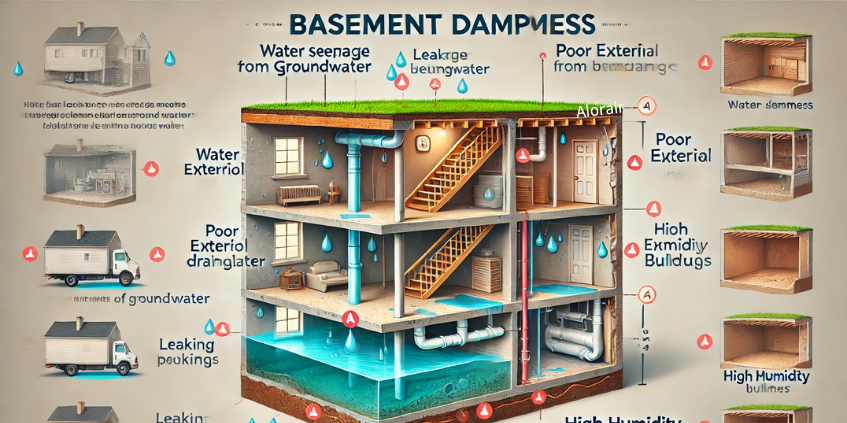Is your basement damp and musty? If you’ve noticed a lingering smell or dampness, you’re not alone. Basements are notorious for poor air circulation, leading to moisture buildup, mold, and even structural damage over time. But how do you effectively circulate air in a basement to prevent these problems?
In this article, we’ll explore why basement ventilation is essential, what causes moisture to accumulate, and how you can get air moving to create a healthier, dryer living space. By the end, you’ll have a solid plan for short-term fixes and long-term solutions to keep your basement well-ventilated—and we’ll even point you toward some powerful moisture-control tools from AlorAir to get started.
What Causes Basement Dampness?
To improve air circulation in your basement, you first need to understand why moisture builds up. One common cause is condensation. When warm, humid air hits cooler basement walls or floors, condensation forms, leaving surfaces damp. This sets up ideal conditions for mold and mildew to thrive.
Seepage is another major issue. Water from the surrounding soil can enter through cracks in your foundation or poorly sealed walls, especially after heavy rain or if the water table rises. Over time, this can make your basement consistently damp. Leaks from plumbing or appliances can also contribute to the problem, with even minor leaks raising humidity levels over time.
Improper drainage around your home can worsen moisture issues. Clogged gutters or downspouts that release water too close to the foundation can cause water to pool, which eventually seeps into your basement.
According to the Department of Energy (DOE), moisture problems don’t just affect air quality, they also reduce energy efficiency. When there’s too much moisture, your HVAC system works harder to control humidity, which drives up energy costs.
Understanding these causes is the first step to solving your moisture issues. Next, we’ll look at how better air circulation can tackle these problems and improve your basement’s environment.

The Importance of Air Circulation
Good air circulation in your basement is essential for preventing moisture problems and maintaining a healthy environment. Without proper airflow, humid air can become trapped, creating the perfect breeding ground for mold, mildew, and dust mites. As time goes on, that stale, musty air in your basement can spread to the rest of your home, exacerbating issues like allergies or respiratory problems.
One of the biggest perks of getting the air moving in your basement is that it helps keep humidity in check. When air flows freely, it stops condensation from building up on cool surfaces, which is usually the starting point for mold. Plus, better ventilation clears out those musty, stale odors that pop up when air just sits around. In the end, your basement won’t just feel more comfortable—it’ll be a healthier space, whether you’re using it for storage or as extra living space.
The Centers for Disease Control and Prevention (CDC) warns that mold exposure can cause a range of health problems, especially for individuals with asthma or weakened immune systems. Proper ventilation can help minimize this risk by keeping humidity under control and preventing mold from taking hold.
If your basement is part of your living space, ensuring good air quality is even more critical. The simple act of improving airflow can make a significant difference in the comfort and safety of your home.
Next, we’ll look at how you can get the air moving in your basement, with practical solutions that can be implemented right away.
Short-Term Solutions for Improving Air Circulation
If your basement feels stuffy and damp, there are some quick and effective ways to start getting the air moving right away. One of the simplest solutions is to install exhaust fans. These fans work by pulling humid air out of the basement and replacing it with fresh air from outside, which can make a noticeable difference in just a short amount of time. You can place them near windows or doors to maximize their effectiveness.
Use Fans
Fans are one of the simplest and most cost-effective ways to circulate air in a basement. Different types of fans can help promote airflow:
Oscillating Fans: These fans move back and forth, distributing air throughout the basement. Place them in different areas to maximize airflow.
Exhaust Fans: Installed in windows or wall vents, exhaust fans pull stale air out of the basement, which can help reduce humidity levels.
Box Fans or Floor Fans: These portable fans can be placed in damp areas to help dry out moisture-prone spots. Positioning a box fan near an open window can also help draw in fresh air or expel stagnant air.
Proper placement is essential for fans to be effective. Avoid obstructing the fans with furniture or storage, and ensure they have a clear path for air movement.

Creating Cross Ventilation
If your basement has windows or doors that open to the outside, use them to create cross ventilation. Open windows on opposite sides of the room to allow fresh air to flow through. For basements with only one window, using a window fan to pull in fresh air or exhaust stale air can be an effective alternative.
Cross ventilation helps to exchange the stagnant indoor air with fresh outdoor air, reducing moisture and improving air quality.
Long-Term Solutions for Improving Air Circulation
For persistent air circulation issues, consider implementing more permanent solutions:
Install a Wall-Mounted Ventilation Fan
Invest in a high-powered ventilation fan like the Ventirpro 720 or VentirPro-S2 with dual fans. These fans are installed directly into an exterior wall, allowing them to continuously pull stale, humid air out of the basement while bringing in fresh air from outside. They’re especially useful in basements with limited windows, ensuring consistent airflow and better air quality.
Upgrade Your HVAC System
If your basement is part of your home’s heating, ventilation, and air conditioning (HVAC) system, extending HVAC ducts to the basement can help distribute air throughout the space. Running the HVAC fan continuously, or installing a Whole-House Fan can enhance air circulation across all rooms, including the basement.
Additionally, upgrading to a smart thermostat with fan control can help automate airflow management, keeping the basement well-ventilated without manual adjustments.
Install a Ductable Dehumidifier
An in-duct dehumidifier like the AlorAir Sentinel HDi90 is a powerful solution for controlling moisture and improving airflow in your basement. Unlike portable units, it integrates with your HVAC system to remove excess humidity from the air, distributing drier, fresher air throughout the space. By maintaining optimal humidity levels, a suitable dehumidifier helps prevent mold growth and improves overall air quality for the long term.
Take Control of Your Basement’s Air Quality
Keeping your basement well-ventilated is essential for preventing moisture buildup, improving air quality, and protecting your home from mold and mildew. By understanding the causes of basement moisture and taking steps to circulate air effectively, you can create a healthier, more comfortable environment.
Ready to take control of your basement’s air quality? Visit AlorAir.com to see our collection of high-quality ventilation fans and moisture-control solutions. With the right tools in place, you’ll ensure your basement stays dry and healthy for years to come.










.jpg)
.jpg)

.jpg)
.jpg)
.HDi90.png)
.HD90.png)









.jpg)
.jpg)
.jpg)





.jpg)
.jpg)


.jpg)








.jpg)
.jpg)








.jpg)
.jpg)























.jpg)
.jpg)
.jpg)





.jpg)
.jpg)
















-.jpg)
.jpg)

.jpg)
.jpg)



























 Exclusive offers
promotions
Exclusive offers
promotions

